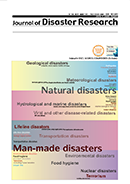In 2018, Japan not only had an abnormally hot summer, but also experienced successive disasters, including the Northern Osaka Earthquake, the Western Japan Heavy Rain, Typhoon No. 21, the Hokkaido Mid Iburi Earthquake, and Typhoon No. 24. In particular, the record-breaking heavy rains continued in a large area of Western Japan from June 28 to July 4, due to the storm front and Typhoon No. 7. The amount of rainfall totaled over 1,800 mm in the Shikoku Region and 1,200 mm in the Tokai Region. The quantity of rain that fell within 48 and 72 hours in both the Chugoku and Kinki Regions, as well as many other areas, was the highest rainfall ever recorded. A special warning regarding heavy rain was issued in 10 prefectures and every kind of disaster that Japan had experienced recently occurred in various locations. As of August 21, a report from Disaster Management Section, Cabinet Office indicated 221 deaths, 9 missing persons, 68 severely injured persons, 319 slightly injured persons, 3 persons with an unknown level of injury, 6,206 destroyed homes, 9,764 severely-damaged homes, 3,765 partially-destroyed homes, 9,006 homes with flooding above the first-floor level, and 20,086 houses with flooding below the first-floor level.
During this large-scale disaster, which was named the Western Japan Heavy Rain, the Disaster Relief Act was applied to 110 municipalities and JDR decided to issue a special edition to address issues pertinent to this specific disaster event. Paper submissions were requested that not only comprised demonstrative researches on hazard and damage characteristics, methods of evacuation, and features of disaster response, but also included introductions of best practices, which were conducted in various fields and prompted diverse collaboration to develop and establish measures to mediate the effect of the future Nankai Trough Earthquake, as well as problems and solutions to successfully realize diverse collaboration. In response to the call for papers for the special issue, nine researches were submitted and six were accepted following a strict review process. To address the category of hazard characteristics analyses, two papers analyzing the characteristics of the flooding resulting from the Western Japan Heavy Rain and one paper comprising an analysis of landslide disasters were accepted. In the category of disaster response, one paper focusing on the use of SNS and two papers regarding the elderly were accepted. It would be our sincere pleasure if this special issue could contribute to future reductions in damage resulting from natural disasters.
抄録全体を表示
